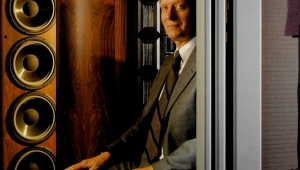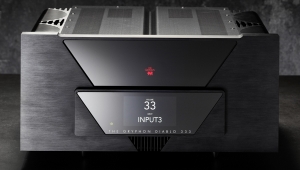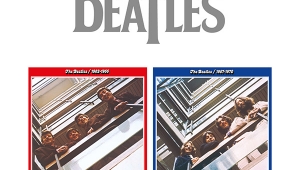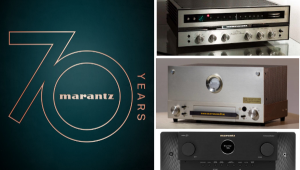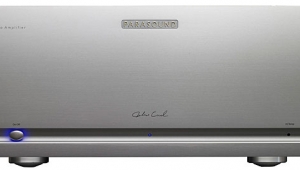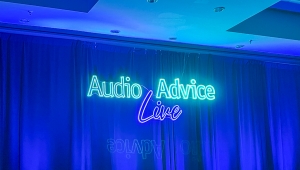| Columns Retired Columns & Blogs |
HI-FI '98 Report, Part Two
From the Show:
June 14: The second and third floors of the Westin generally sport the larger exhibits, with a corresponding propensity for BIG BASS. Just like cars on an urban street, rooms here competed in the boom wars, with Show management called in to referee once in while.
Not surprisingly, Wilson Audio, as demonstrated in the L.A. Audio suite, had plenty of firepower ready---their new $38,000/pair MAXX speaker was on display, fronting two boxcar-sized woofer towers. Amplification was from Krell, and a Runco DTV1000 rested on a steel truss. The music portion of the demo was rather polite, but the movie trailer from Titanic bounced the chairs and, no doubt, the neighbors.
During the Martin-Logan demo on the same floor, delicate choral music was interrupted by the thud thud thud of overblown video. Not to be outdone, Gayle Sanders exclaimed, "Don't worry, in just a few minutes we'll exact our revenge." Sure enough, a 30Hz pedal note from a monstrous organ shook the M-L room . . . and, likely, a few others.
In this same room, the Martin-Logan Statements were being displayed by Southern California dealer Christopher Hansen, along with 12 VTL Wotan MB-1250 monoblocks fronted by a Wadia transport and converter and Z-systems' new rdq-6 digital equalizer. This was easily one of the Show's more well-paced and dramatic presentations---Elvis himself made an appearence with a bigger-than-life rendition of the tune "Fever," a most inspired choice.
Overcoming the Westin Hotel's low-voltage problems, Hales and Balanced Audio Technologies presented four cuts in a demonstration that introduced the latest Hales speaker, the Transcendence 8, and featured BAT electronics. Expected to ship in about four weeks, a pair of the Transcendence 8s will retail for $8990 and feature proprietary aluminum drivers. Considering the room's odd shape, the sound was surprisingly smooth and immediate. Also of note were the pARTicular Contemporary Design stands, which displayed the BAT products to good effect.
For some reason, Sunday brought more kids to the Show, which points to the need for audiophiles to not only share their passion with other middle-aged friends, but also with impressionable up-and-comers.
We conducted an informal exit poll in the lobby and got the following reactions from the Stewart family of Lecompton, Kansas. Bob Stewart, 14, claimed "we saw more movie stars here than at Universal Studios," while his brother John, 6, claimed that the Show was "as good as Disneyland." Four-year-old Mary hid behind her Dad's back. The Stewarts' favorite room: the Christopher Hansen Suite featuring the Martin-Logan Statements. They also asked when famed audiophile Fabio would appear . . .
June 13: NXT presented working prototypes of their unique flat-panel technology. Visitors to the NXT suite were able to pass around a "live" foam-core panel while it was playing music. NXT's Director of Sales and Marketing, Jon Vizor, explained how the speaker worked and presented several possible applications, including slide-out flat speakers in a portable computer, hang-on-the-wall center and stereo speakers. and ceiling panels.
An interesting result of the flat-panel design is that the perceived loudness of the audio tends to be about the same whether your ear is right up against the panel or several feet back. Jon explained that this was due to the wide area of dispersion resulting from a flat-panel design: as you move your ear closer, you are hearing a correspondingly smaller portion of the panel and therefore less overall sound. As you move back, more of the panel's output is getting to your ear. He likened this to the effect of a small violin filling a large room with sound radiated from the entire instrument body while not deafening the musician right next to it. If that same musician had a conventional point-source speaker loud enough to fill that hall next to her ear, it would "literally cut her head off."
There are usually a few rooms that generate a buzz among the Stereophile writers as we huddle in the halls, the press room, and at meals. This year, the buzz for product with most impressive value centered around Anthony Gallo Acoustics and their Bose-killer Nucleus Micro system, which sells for a modest $699. But the value becomes overwhelming when you hear these softball-sized speakers (and their bowling-ball-sized subwoofer) put out sound that equals some of the best $1000+ conventional box systems.
At the other end of the economy scale, Canorus' Steven Lee demonstrated Nagra's new VPA pure class-A 50Wpc monoblock amplifiers, based on a pair of direct-heated, thoriated tungsten 845 output triode tubes. He used a dCS 972/Elgar combination to play a variety of digital formats for comparison. We heard 16-bit/44.1kHz Red Book CD, upsampled 44.1kHz to 192kHz music using the dCS 972, 24-bit/96kHz high-resolution audio on DVD, and live-to-2-track, 24-bit, 192kHz recording-session tapes produced using two synchronized Nagra-D recorders. Even standing to the side in this room, the difference was not subtle: the music flowed more smoothly as the bit and sampling rates increased.
On the 12th floor of the Westin Hotel, Meridian filled several rooms with their latest digital gear, with one room devoted to historical products stretching back to 1973 and the original Lecson preamp. This prompted a discussion among several attendees in the suite regarding the need for a high-end audio museum, perhaps sponsored by the Academy. Why not gather prototypes, significant technology breakthroughs, and design achievements, create a road show, and send it out to shopping malls around the world?
At the "Perfect Sound Forever" seminar, moderator Paul Miller, Stereophile's in-house test and measurement consultant, explained how the new tests and measurements being published in the magazine are used to illuminate the limitations inherent in the existing 16-bit/44.1kHz CD standard.
The seminar began with a discussion of digital jitter and a demonstration of Paul's Jitter Measurement Suite, used by John Atkinson in his evaluations of CD equipment. Actual data from CD players were used to illustrate the subjective consequences of jitter-related distortion. The various jitter fingerprints attributable to different chipsets were exposed.
Comparisons between multibit, bitstream, and hybrid DAC technologies were made using Paul's 3D Data Visualization program, which allows patterns of distortion, noise, and sampling images to be seen and heard in a way impossible when utilizing conventional two-dimensional measurement techniques. These astonishing color images will soon appear in Stereophile.
When all is said and done, though, one "audio" event stood out by the end of the day: a live concert featuring guitarists Vlatko Stefanovski and Miroslav Tadic. Sponsored by MòA Recordings, who have also released several of Stefanovski's and Tadic's works, this show featured ancient folk music of Macedonia that practically brought tears to the eye. Absolutely elegant and heartfelt, their music alternated between deep, melancholic melodies and rapid-fire notes that lit up the room.
- Log in or register to post comments
